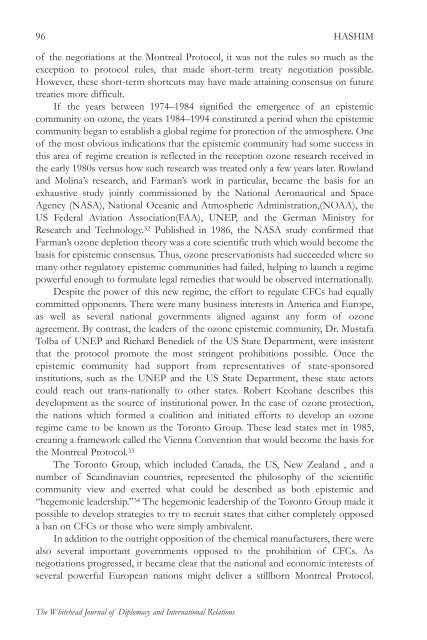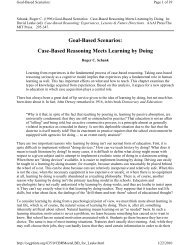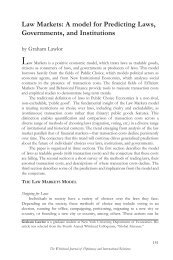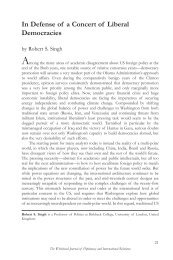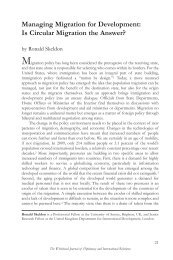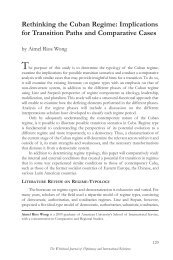Free Riders, Side Payments, and International Environmental ...
Free Riders, Side Payments, and International Environmental ...
Free Riders, Side Payments, and International Environmental ...
Create successful ePaper yourself
Turn your PDF publications into a flip-book with our unique Google optimized e-Paper software.
96<br />
The Whitehead Journal of Diplomacy <strong>and</strong> <strong>International</strong> Relations<br />
HASHIM<br />
of the negotiations at the Montreal Protocol, it was not the rules so much as the<br />
exception to protocol rules, that made short-term treaty negotiation possible.<br />
However, these short-term shortcuts may have made attaining consensus on future<br />
treaties more difficult.<br />
If the years between 1974–1984 signified the emergence of an epistemic<br />
community on ozone, the years 1984–1994 constituted a period when the epistemic<br />
community began to establish a global regime for protection of the atmosphere. One<br />
of the most obvious indications that the epistemic community had some success in<br />
this area of regime creation is reflected in the reception ozone research received in<br />
the early 1980s versus how such research was treated only a few years later. Rowl<strong>and</strong><br />
<strong>and</strong> Molina’s research, <strong>and</strong> Farman’s work in particular, became the basis for an<br />
exhaustive study jointly commissioned by the National Aeronautical <strong>and</strong> Space<br />
Agency (NASA), National Oceanic <strong>and</strong> Atmospheric Administration,(NOAA), the<br />
US Federal Aviation Association(FAA), UNEP, <strong>and</strong> the German Ministry for<br />
Research <strong>and</strong> Technology. 32 Published in 1986, the NASA study confirmed that<br />
Farman’s ozone depletion theory was a core scientific truth which would become the<br />
basis for epistemic consensus. Thus, ozone preservationists had succeeded where so<br />
many other regulatory epistemic communities had failed, helping to launch a regime<br />
powerful enough to formulate legal remedies that would be observed internationally.<br />
Despite the power of this new regime, the effort to regulate CFCs had equally<br />
committed opponents. There were many business interests in America <strong>and</strong> Europe,<br />
as well as several national governments aligned against any form of ozone<br />
agreement. By contrast, the leaders of the ozone epistemic community, Dr. Mustafa<br />
Tolba of UNEP <strong>and</strong> Richard Benedick of the US State Department, were insistent<br />
that the protocol promote the most stringent prohibitions possible. Once the<br />
epistemic community had support from representatives of state-sponsored<br />
institutions, such as the UNEP <strong>and</strong> the US State Department, these state actors<br />
could reach out trans-nationally to other states. Robert Keohane describes this<br />
development as the source of institutional power. In the case of ozone protection,<br />
the nations which formed a coalition <strong>and</strong> initiated efforts to develop an ozone<br />
regime came to be known as the Toronto Group. These lead states met in 1985,<br />
creating a framework called the Vienna Convention that would become the basis for<br />
the Montreal Protocol. 33<br />
The Toronto Group, which included Canada, the US, New Zeal<strong>and</strong> , <strong>and</strong> a<br />
number of Sc<strong>and</strong>inavian countries, represented the philosophy of the scientific<br />
community view <strong>and</strong> exerted what could be described as both epistemic <strong>and</strong><br />
“hegemonic leadership.” 34 The hegemonic leadership of the Toronto Group made it<br />
possible to develop strategies to try to recruit states that either completely opposed<br />
a ban on CFCs or those who were simply ambivalent.<br />
In addition to the outright opposition of the chemical manufacturers, there were<br />
also several important governments opposed to the prohibition of CFCs. As<br />
negotiations progressed, it became clear that the national <strong>and</strong> economic interests of<br />
several powerful European nations might deliver a stillborn Montreal Protocol.


